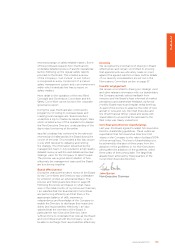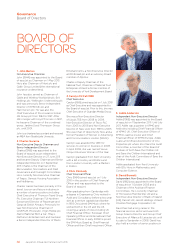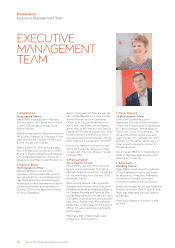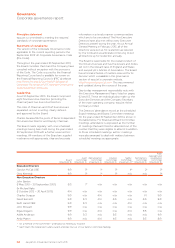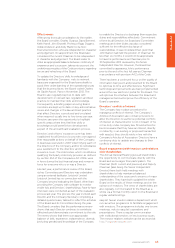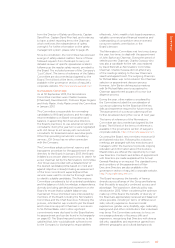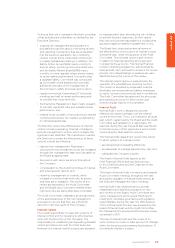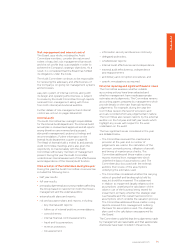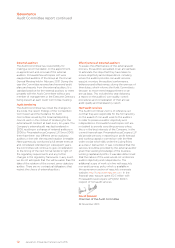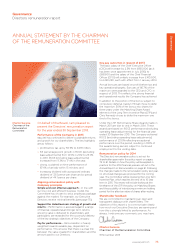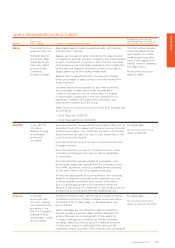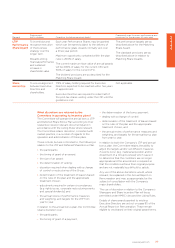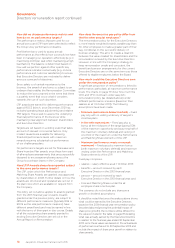EasyJet 2013 Annual Report Download - page 71
Download and view the complete annual report
Please find page 71 of the 2013 EasyJet annual report below. You can navigate through the pages in the report by either clicking on the pages listed below, or by using the keyword search tool below to find specific information within the annual report.
www.easyJet.com 69
Governance
To ensure that risk is managed effectively, a number
of key activities are undertaken, as defined by the
Executive Directors:
• ongoing risk management and assurance is
provided through the various monitoring reviews
and reporting mechanisms that are embedded
into the business operations. Key monitoring
reviews include those conducted continuously
in weekly operational meetings. In addition, the
Safety Action Group (SAG) meets monthly to
discuss safety, security and environmental risks
and the Safety Review Board (SRB) meets
monthly, or more regularly where events require,
to review safety performance. During the year
a separate Safety Committee was constituted
(a Committee of the Board) which provides
additional oversight of the management of
the Company’s safety processes and systems;
• regular commercial, financial and IT functional
meetings are held to review performance and
to consider key issues and risks;
• the Executive Management Team meets regularly
to consider significant risks and overall business
performance; and
• Internal Audit considers, reviews and tests internal
controls and business risk matters, as defined by
its risk based audit plan.
The Directors review the effectiveness of internal
control, including operating, financial, compliance
and risk management controls, which mitigate the
significant risks identified. The mechanisms used by
the Directors to review the effectiveness of these
controls include the following:
• reports from management. Reporting is
structured to ensure that key issues are escalated
through the management team and ultimately to
the Board as appropriate;
• discussions with senior personnel throughout
the Company;
• consideration by the Audit Committee of internal
and external audit reports; and
• review by management of controls, which
mitigate or minimise high-level risks, to ensure
that they are in operation. The results of this
review are reported to the Audit Committee
and the Board which considers whether these
high-level risks are being effectively controlled.
The Audit Committee undertakes an annual review
of the appropriateness of the risk management
processes to ensure that they are sufficiently
robust to meet the needs of the Company.
Internal control
The overall responsibility for easyJet’s systems of
internal control and for reviewing its effectiveness
rests with the Directors of the Company. The
responsibility for establishing and operating detailed
control procedures lies with the Chief Executive.
However, the internal control systems are designed
to manage rather than eliminate the risk of failure
to achieve business objectives. By their nature,
they can only provide reasonable but not absolute
assurance against material misstatement or loss.
The Board has conducted an annual review of
the effectiveness of the system of internal control
during the year, under the auspices of the Audit
Committee. This included systems and controls
in relation to financial reporting processes and
in preparing the accounts. The Internal Financial
Control monitoring programme, administered by
Internal Audit, has continued to enhance the review
process. No material failings or weaknesses were
identified during the course of this review.
The internal control regime is supported by the
operation of a whistleblower reporting function.
The system is operated by a specialist external
third-party service provider and allows employees
to report concerns anonymously and in confidence.
The Audit Committee has approved the processes
and reporting structure for the function and
receives regular reports on its operation.
Internal Audit
Internal Audit’s work is designed to provide
effective risk based coverage over the internal
control environment. This is summarised in an audit
plan, which is approved by the Board and the Audit
Committee and updated on a rolling basis. For
example, during the year the audit plan was flexed
to include reviews of the governance and controls
surrounding the fleet selection process.
The Internal Audit department reviews the extent
to which systems of internal control:
• are designed and operating effectively;
• are adequate to manage easyJet’s key risks; and
• safeguard the Company’s assets.
The Head of Internal Audit reports to the
Chief Financial Officer and has direct access
to the Chief Executive and the Chairman of the
Audit Committee.
The Head of Internal Audit is invited to and attends
Audit Committee meetings throughout the year
and reports regularly on Internal Audit reviews at
the Executive Management Team meetings.
Internal Audit’s key objectives are to provide
independent and objective assurance on risks
and controls to the Board, Audit Committee and
senior management, and to assist the Board in
meeting its corporate governance and regulatory
responsibilities. During the year, the effectiveness
of the Internal Audit function was assessed by the
Head of Internal Audit and the Audit Committee;
this followed a formal external effectiveness review
completed in 2011.
The role of Internal Audit and the scope of its
work continue to evolve to take account of changes
within the business and emerging best practice. A
formal audit charter is in place.


